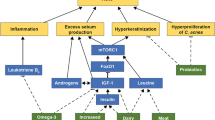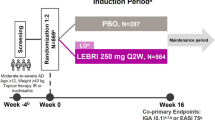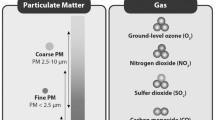Summary
Atopic dermatitis is a common skin disease in children from western countries. Its pathogenesis is complex and involves genetic and environmental factors. The relevant genes need to be in the relevant environment (allergens, adjuvant factors). The increase in prevalence of atopic dermatitis underlines the role of environmental factors and has led to attempts to prevent atopic dermatitis. A considerable number of risk factors have been implicated in the development of atopic dermatitis. This field of research is characterised by many claims and few confirmations. Preventive measures focus on the reduction of allergen exposure during the first months of life. However, passive smoking is an important risk factor that should be addressed in a prophylactic program. Dietary intervention during the first 4 to 6 months has been documented to result in temporary reduction in incidence of food allergy and atopic dermatitis. Promising results have been obtained in a study combining dietary and environmental measures. As there is insufficient information on the efficacy of such measures, it is too early to advise them on a large scale. Other measures like breast-feeding and stopping passive smoking, potentially preventing atopic dermatitis, can be advised anyway due to general health considerations.
Samenvatting
Atopisch eczeem heeft een hoge prevalentie bij kinderen in Westerse landen. De pathogenese is complex en resulteert uit interacties tussen genetische aanleg en omgevingsfactoren (allergenen, adjuvante factoren). De toename van de prevalentie van atopisch eczeem onderstreept het belang van omgevingsfactoren voor de pathogenese ervan. Een groot aantal risicofactoren wordt in verband gebracht met het ontstaan van atopisch eczeem. Bij preventieve maatregelen ligt de nadruk op de vermindering van blootstelling aan allergenen (voedingsmiddelen, huisstofmijt, huisdieren). Passief roken mag als risicofactor niet worden vergeten. Er zijn aanwijzingen dat diëtaire maatregelen gedurende de eerste 4 à 6 maanden resulteren in een tijdelijke vermindering van voedselallergie en atopisch eczeem. Veelbelovend zijn de resultaten van een studie waarin een combinatie van maatregelen gebruikt werd (dieet, reductie van huisstofmijt). De effectiviteit hiervan staat echter nog niet vast, zodat het nog te vroeg is om adviezen voor de preventie van atopisch eczeem hierop te baseren. Hoewel van adviezen als niet roken in het bijzijn van het kind of in de zwangerschap en het geven van borstvoeding het preventief effect niet bewezen is, zijn zij mede gezien de algemene voordelen ervan zeker nastrevenswaardig.
Similar content being viewed by others
literatuur
Schultz Larsen F. The epidemiology of atopic dermatitis. Monogr Allergy 1993;31:9-28.
Mao XQ, Shirakawa T, Yoshikawa K, et al. Association between genetic variants of mast cell chymase and eczema. Lancet 1996;348:581-3.
Hershey GHK, Friedrich MF, Esswein LA, et al. The association of atopy with a gain-of-function mutation in the alpha subunit of the interleukin-4 receptor. N Engl J Med 1997;337:1720-5.
Cox HE, Moffatt MF, Faux JA, et al. Association of atopic dermatitis to the beta subunit of the high affinity immunoglobulin E receptor. Br J Dermatol 1998;138:182-7.
Peat JK, Berg R van den, Green WF, et al. Changing prevalence of asthma in Australian children. Br Med J 1994;308: 1591-6.
Taylor B, Wadsworth J, Wadswoth M, Peckham C. Changes in the reported prevalence of childhood eczema since the 1939-45 war. Lancet 1984;2:1255-7.
Burr ML, Butland BK, King S, Vaughan-Williams E. Changes in asthma prevalence: two surveys 15 years apart. Arch Dis Child 1989;64:1452-6.
Schultz Larsen F. Atopic dermatitis: a genetic-epidemiologic study in a population-based twin sample. J Am Acad Dermatol 1993;28:719-3.
Ninan TK, Russell G. Respiratory symptoms and atopy in Aberdeen schoolchildren: evidence from two surveys 25 years apart. Br Med J 1992;304:873-5.
Sears MR. Descriptive epidemiology of asthma. Lancet 1997;350(suppl II):1-4.
Williams HC, Robertson C, Stewart A, et al. Worldwide variations in the prevalence of symptoms of atopic eczema in the international study of asthma and allergies in childhood. J Allergy Clin Immunol 1999;103:125-38.
Shaheen SO, Aaby P, Hall AJ, et al. Measles and atopy in Guinea-Bissau. Lancet 1996;347:1792-6.
Shirakawa T, Enomoto T, Shimazu S, Hopkin J. The inverse association between tuberculin responses and atopic disorders. Science 1997;275:77-9.
Von Mutius E, Martinez FD, Fritzsch C, et al. Differences in the prevalence of asthma and atopy in two areas of West and East Germany. Am J Respir Crit Care Med 1994;149:358-64.
Von Mutius E, Fritzsch C, Weiland SK, et al. The prevalence of asthma and allergic disorders among children in united Germany: a descriptive comparison. Br Med J 1992;305:1395-9.
Guillet G, Guillet M-H. Natural history of sensitizations in atopic dermatitis. Arch Dermatol 1992;128:187-92.
Langeveld-Wildschut EG, Thepen T, Bihari IC, et al. Evaluation of the atopy patch test and the cutaneous late phase reaction, as relevant models for the study of allergic inflammation in patients with atopic eczema. J Allegy Clin Immunol 1996;98:1019-27.
Fergusson DM, Horwood LJ, Shannon FT. Early solid feeding and recurrent childhood eczema: a 10 year longitudinal study. Pediatrics 1990;86:541-6.
Zeiger RS, Heller S, Mellon MH. Effect of combined maternal and infant food-allergen avoidance on development of atopy in early infancy: a randomized study. J Allergy Clin Immunol 1989;84:72-89.
Zeiger RS, Heller S. The development and prediction of atopy in high-risk children: follow-up at age seven years in a prospective randomized study of combined maternal and infant food allergen avoidance. J Allergy Clin Immunol 1995;95: 1179-90.
Falth-Magnusson K, Kjellman NI. Allergy prevention by maternal elimination diet during late pregnancy: a 5-year follow-up of a randomized study. J Allergy Clin Immunol 1992;89: 709-13.
Golding J, Emmett PM, Rogers IS. Eczema, asthma and allergy. Early Human Develop 1997;49(Suppl):S121-30.
22>23 Saarinen UM, Kajosaari M. Breastfeeding as prophylaxis against atopic disease: prospective follow-up study until 17 years old. Lancet 1995;346:1065-9.
Gruelee CG, Sanford HN. The influence of breast feeding on infantile eczema. J Pediatr 1936;9:223-5.
Sporik R, Holgate ST, Platts-Mills TAE, Cogswell JJ. Exposure to house dust-mite allergen (Der pI) and the development of asthma in childhood. N Engl J Med 1990;323:502-7.
Tan BB, Weald D, Strickland I, Friedmann PS. Double-blind controlled trial of effect of housedust-mite allergen avoidance on atopic dermatitis. Lancet 1996;347:15-8.
Arshad SH, Matthews S, Gant C, Hide DW. Effect of allergen avoidance on development of allergic disorders in infancy. Lancet 1992;339:1493-7.
Hide DW, Matthews S, Tariq S, Arshad SH. Allergen avoidance in infancy and allergy at 4 years of age. Allergy 1996; 5:89-93.
Schafer T, Dirschedl P, Kunz B, et al. Maternal smoking during pregnancy and lactation increases the risk for atopic eczema in the offspring. J Am Acad Dermatol 1997;36:550-6.
Schafer T, Vieluf D, Behrendt H, et al. Atopic eczema and other manifestations of atopy: results of a study in East and West Germany. Allergy 1996;51:532-9.
Dold S, Wjst M, Von Mutius E, et al. Genetic risk for asthma, allergic rhinitis, and atopic dermatitis. Arch Dis Child 1992;67:1018-22.
Bergmann KE, Bergmann RL, Schilz J, et al. Prediction of atopic disease in the newborn: methodological aspects. Clin Exp Allergy 1990;20:21-6.
Author information
Authors and Affiliations
Additional information
Afdeling Dermato-venereologie, Academisch Ziekenhuis Rotterdam.Correspondent: A. Wolkerstorfer, kinderdermatoloog, afd. Dermatologie-Venereologie, Academisch Ziekenhuis Rotterdam / Sophia Kinderziekenhuis, dr. Molewaterplein 60, 3015 gj Rotterdam.
Rights and permissions
About this article
Cite this article
Wolkerstorfer, A., Oranje, A.P. Preventie van atopisch eczeem. KIND 68, 179–182 (2000). https://doi.org/10.1007/BF03061305
Issue Date:
DOI: https://doi.org/10.1007/BF03061305




